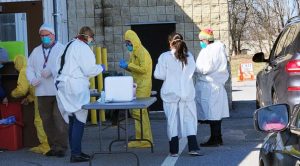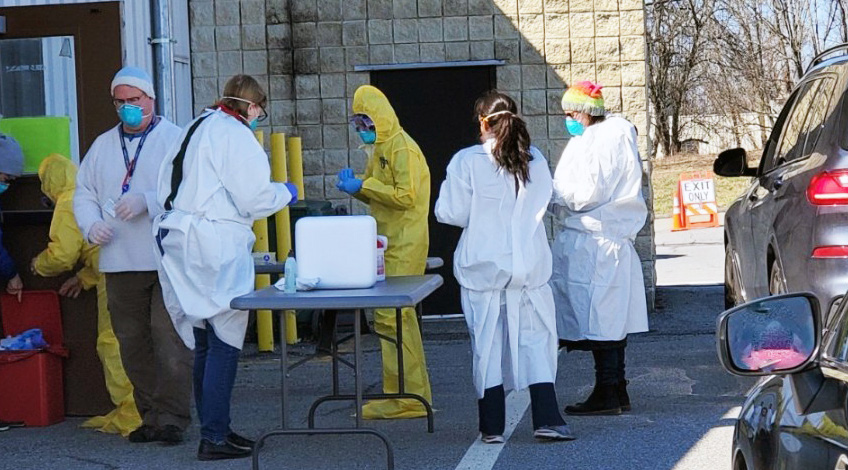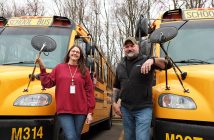Editor’s note: New York State has been hard hit by COVID-19, with nearly 60,000 cases and nearly 1,000 deaths statewide as this edition went to press. These numbers are expected to grow significantly.
Through it all, CSEA members, including those employed in essential services such as health care, direct care, correctional facilities and many more settings, are continuing to provide vital services.
They are also on the front lines responding to this pandemic, making sure our communities are as healthy and safe as possible, including continuing to provide basic needs to those who need it the most.
Also closely monitoring the crisis is our union’s Occupational Safety and Health Department, where our staff professionals are ready to provide expert guidance to our members.
In this edition are numerous stories and accounts of our members providing these services.

CSEA members working for the Putnam County Department of Health staff a drive-through mobile testing clinic. (Photo by Putnam County Health Department – NY Facebook page)
Public health workers on the front lines
BREWSTER — While the coronavirus outbreak is new territory for many, CSEA members working in public health have been training for a time such as this.
Federal, state, and county public health workers keep their skills sharp through continuing education and following data on trends. While supply shortages and other issues are creating challenges, our members’ expertise is on full display.
“We have been training for this for years, said Putnam County Local President Jane Meunier, who was recently appointed chair of our Statewide Occupational Safety and Health Committee. “I have to say, our staff is doing a phenomenal job. They are under a tremendous amount of stress and the situation is changing every day, but they’re holding it together.”
Bordering Westchester County, where the initial outbreak of cases in our state occurred, the public health staff started preparing for the virus to hit Putnam County.
Following the creation of the first drive-through testing site in New Rochelle, workers in Putnam County created their own site.
Staffed by our members working as public health nurses, the testing site is at an undisclosed location to prevent a sudden influx of traffic. People being tested must have an appointment and a doctor’s note. County workers are rotating shifts to allow for social distancing and much-needed rest periods.
“I am confident our health department is extremely prepared for this,” Meunier said. “Right now, I think we’re depending upon people following the recommendations of social distancing and people taking this seriously. This is not a joke.”
Meunier added that as CSEA members, we can also do our part by being supportive of fellow union brothers and sisters who are also doing vital work.
“We need to be the leaders that we are,” said Meunier. “We need to be supportive of our brothers and sisters working the front lines, such as people working in the grocery stores and pharmacies. This is very stressful for them and we need to be kind to each other.”
— Jessica Ladlee
 “I’ve been helping to train hospital staff on isolation precautions, how to perform swabbing for coronavirus tests as well as personal safety. At this point, it’s training, training and retraining. I’m a nurse, so it feels great to use my skillset to help hospital staff.”
“I’ve been helping to train hospital staff on isolation precautions, how to perform swabbing for coronavirus tests as well as personal safety. At this point, it’s training, training and retraining. I’m a nurse, so it feels great to use my skillset to help hospital staff.”
— Simon Ulubabov, nurse educator, Nassau University Medical Center (photo provided by Lynne Kramer)
 “We’re watching out for our county. I call the county our family. We’re watching out to make sure the people in Oneida County are staying healthy. If they are tested, we want to make sure they stay safe and that we get their temperatures and that they don’t spread it to anyone else. We just want to make sure everyone stays healthy.”
“We’re watching out for our county. I call the county our family. We’re watching out to make sure the people in Oneida County are staying healthy. If they are tested, we want to make sure they stay safe and that we get their temperatures and that they don’t spread it to anyone else. We just want to make sure everyone stays healthy.”
— Marina Kistner, RN, Oneida County Public Health Department and CSEA Oneida County Unit Secretary




